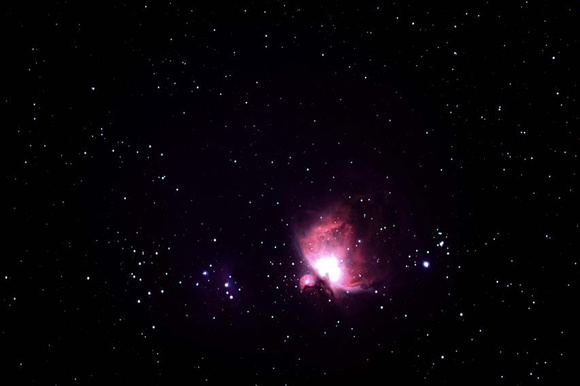M42
Other Names: Orion Nebula, NGC 1976
Optics: Borg Astrograph 101ED at f/4.1
Mount: Atlas EQG using The Sky6 and EQMOD
Camera: Canon EOS 50D [ UV/IR filter modification by Hap Griffin ]
Filters: IDAS Light Pollution Suppression (LPS) Filter
Exposure: 74 Mins [10 x 300s, 75 x 15s, 10 x 30s at ISO 800]
Accessories: Auto guided with Borg 45ED and Orion Starshoot Auto guider using PHD
Location: Calgary, AB
Date: Jan 18, 2010
Notes: Processing: Image acquisition with Maxim DSLR. Image calibration, align, and combine in Maxim DSLR. Levels, curves, crop and resize in Photoshop.
Calibrated w/10 Darks, 40 Bias, 40 Flats using light box, Ambient temperature was -11C, and -2C over 2 nights.
The Orion Nebula (also known as Messier 42, M42, or NGC 1976) is a diffuse nebula situated south[b] of Orion's Belt. It is one of the brightest nebulae, and is visible to the naked eye in the night sky. M42 is located at a distance of 1,344 ± 20 light years[2][5] and is the closest region of massive star formation to Earth. The M42 nebula is estimated to be 24 light years across. Older texts frequently referred to the Orion Nebula as the Great Nebula in Orion or the Great Orion Nebula.
The Orion Nebula is one of the most scrutinized and photographed objects in the night sky, and is among the most intensely studied celestial features.[6] The nebula has revealed much about the process of how stars and planetary systems are formed from collapsing clouds of gas and dust. Astronomers have directly observed protoplanetary disks, brown dwarfs, intense and turbulent motions of the gas, and the photo-ionizing effects of massive nearby stars in the nebula. There are also supersonic "bullets" of gas piercing the dense hydrogen clouds of the Orion Nebula. Each bullet is ten times the diameter of Pluto's orbit and tipped with iron atoms glowing bright blue. They were probably formed one thousand years ago from an unknown violent event.


